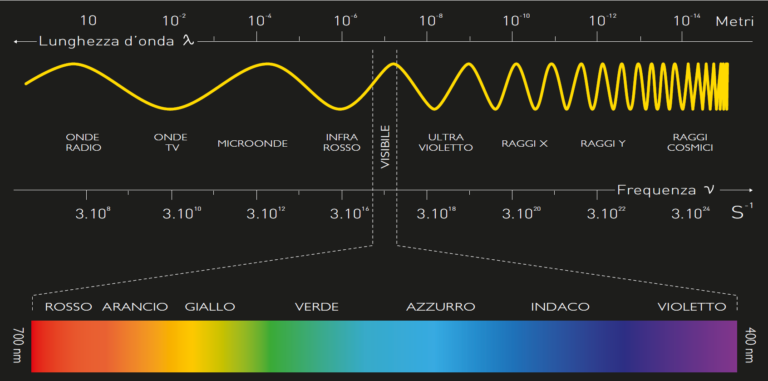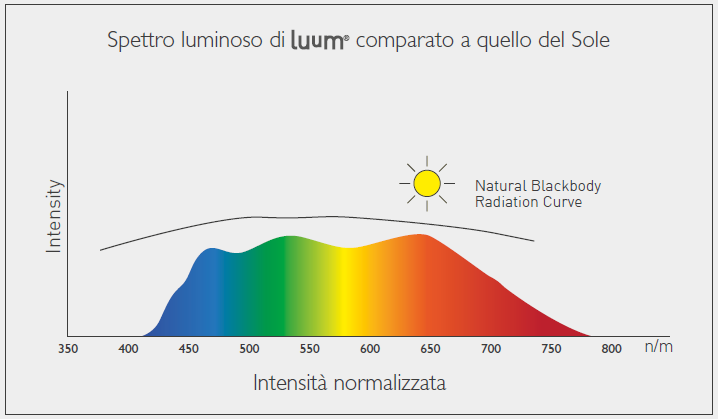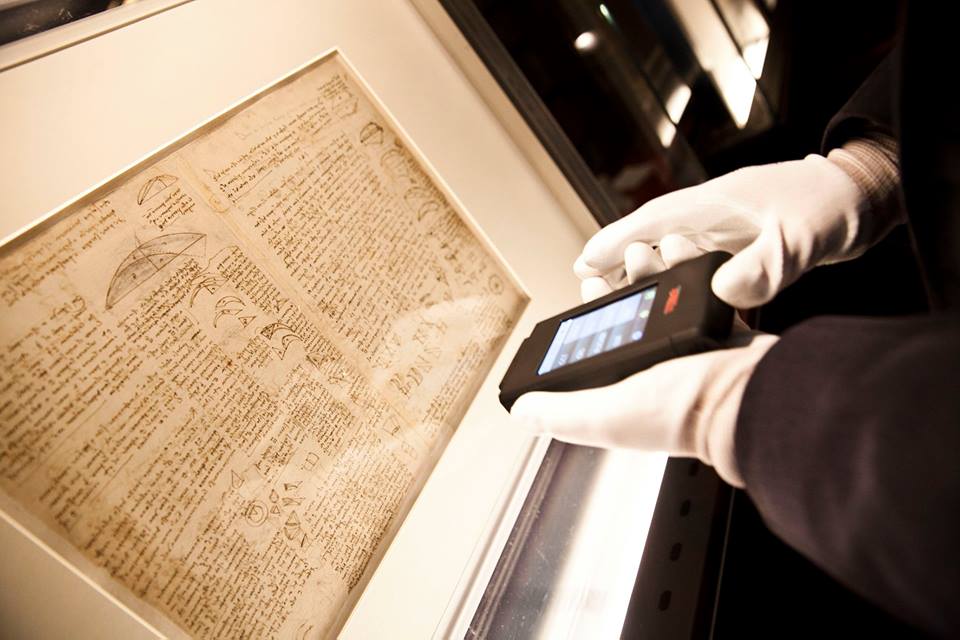


Light
Light is that part of the electromagnetic spectrum visible to the human eye (400-700nm). It’s characterized by four fundamental physical aspects: quantity, quality, direction and periodicity. These four must be accurately considered for a correct design of lighting tools. In the same way we have to consider psycho-perceptive aspects that interact light/object/observer, such as: size, value, material, support, direction, texture, shape. In light perception and in the resulting image creation, come into play experiential and personal factors that give the colour experience: color volume, color surface, color layer and the experience of synesthesia. For a perfect visual comfort we need to think through the biological effects of light, resulting from the electromagnetic spectrum quality on the retina, metabolism, environment, objects, on artworks, and on our mood.

LIGHT AND ARTIFICIAL LIGHT
For thousand years the only artificial light sources were derived from the combustion of substances available in nature. Torch, oil lamp, candles, gas or kerosene lamps, then in 1880 the advent of light bulbs. Later fluorescent lights, discharge lights and recently the LEDs. The evolution of artificial light sources in the last two centuries focused on improving efficiency was in terms of increasing in emitted Lumen (lm) and in reduction of energy (W). Many times increasing efficiency has also replaced the importance of the emitted light spectrum quality. This is particularly manifest in the case of LEDs currently on the market, whose rapid spread begins to pose problems regarding the proper lighting, visual comfort and eye health. (See Related Scientific articles) The awareness of the significance of light quality was the starting point for Luum® for seeking new LED sources capable to get-together energy efficiency and light spectrum quality. Since years Luum® is selecting the best of LED light sources existing on the market, many times requiring customized purchases, able to overcome the low quality problems.


ENVIRONMENT
Environments and closed spaces, their use and the objects in it deeply interact with light. The variables are several to count, such as volumes, surfaces, materials, walls, openings, space target use, trails, objects and between these also special objects such as sculptures, reliefs, paintings and even in addition curvilinear, straights, rough, soft, reflective, transparent and sharp locations and environments. Visual comfort and the well-being, consequential from it, are the result of a correct analysis and of a proper application of light features and of the enlighten environment. Quality of the light source, irradiation, direction of the light, quantity of light that hits an object, object characteristics, environmental features, standard observer, and individualities variations are key variables in the preliminary analysis for lighting design.




HUMAN NECESSITIES
Indeed the psycho-perceptual, biological, emotional, cultural, social, personal needs make essential the design, production and the installation of tools suited to emit correct light for any environment and for any needs. Just in this way light can satisfy basic needs like security illuminations, light for working, writing, reading; light to make conversation, eat, relax; courtesy lights; and even architectural lighting, emotional; decorative light. Visual comfort is the result of the blend of complex variables that take place analyzing and calibrating:
- Light source (meant as: incandescent lamp, fluorescent, LED or other);
- Object (meant as a body that is illuminated);
- Standard observer (meant as the ideal person who observes the object);
- Context (meant as the environment in which the action takes place in the “see”);
- Person (meant as the concrete physical person -man, woman, child, senior- eligible for lighting).
Person (meant as the concrete physical person -man, woman, child, senior- eligible for lighting).
Luum® tools help lighting designers converting a simple lighting to a very high visual comfort lighting with physical and mental benefits.


VISUAL COMFORT
Luum® LED sources allow a better visual comfort. This is highly desirable since the sense stimuli that the brain processes come more than 80% from our eyesight. The importance of this sensorial channel is not only related to the image formation but also the activation of hormonal processes that govern the circadian rhythm (sleep-wake cycle). In this way, light has a triple effect on human beings: Visual – relating the image construction; light able to allow adequate visibility of shapes, details, colors. Biological – relating the physiological (metabolic and hormonal) stimulation; high quality light that can bring energetic effects, alertness and attention; which can positively influence cognitive memory skills, language, learning, problem solving, reasoning and decision-making; which is able to give circadian rhythm stability and quality of sleep. Emotional – relating structuring and creation of atmospheres; which influences the mood and stress.


THE IMPORTANCE OF LIGHT FOR HUMAN HEALTH AND WELLBEING
More than 80% of the sensory stimuli that our brain receives come from our eyes, putting light in a primary position for human physiology. Sunlight is responsible of what we see but it is also the most important timer for our internal clock. In fact, natural light controls our circadian rhythm, a mechanism, also known as the sleep / wake cycle, which regulates the phases of sleep and alertness of the brain at regular intervals over a period of 24 hours.
The intensity and colour of light sends different messages to the brain that reacts by regulating a wide range of biological processes.
The arrival of artificial light has profoundly influenced the periodism of
Natural light, causing many problems for human health.
Moreover, most of the world population spends about 90% of their time indoors and for Ills reason If is essential that artificial light is designed to resemble as much as possible the light produced by the sun, in terms of intensity, colour and cyclicality in the 24 hours.

INFLUENCE OF LOW QUALITY LED LIGHT ON HUMAN HEALTH
Commonly used LED emit strong light radiation on the blue spectrum. This intense high energy light spike causes Blue Hazard. A potential risk for a photo-chemically induced retinal injury resulting from exposure to electromagnetic radiation at wavelengths mainly between 400 and 450 nm. This means that LEDs currently used in our homes, hospitals, schools, etc., can cause various disturbances of the circadian rhythm, metabolism and damage to our eyes. 
Intrinsically photosensitive ganglion cells contain their own photopigment, melanopsin, which causes them to react directly to blue light.
They project to the suprachiasmatic nucleus (SCN) via the retinohypothalamic tract for setting and maintaining circadian rhythms. 
Blue light causes permanent eye damage and can contribute to age-related macular degeneration. Disruptions of the circadian rhythm
Digital eye syndrome: blurred vision, difficulty focusing, dry eyes, headache, neck and back pain, Increased risk of some cancers, Increased risk of diabetes, heart disease and obesity, Increased risk of depression.
HOW THE RESEARCH CARRIED OUT AT THE I.R.C.C.S. SAN RAFFAELE HOSPITAL IN COLLABORATION WITH LUUM.
CLICK TO DOWNLOAD THE PDF.
LOW QUALITY LED LIGHT AND THE DEGRADATIVE EFFECT ON MASTERPIECE
The degrading action of light on the pigments of the colors of paintings has long been known. Prolonged exposure, especially to light radiation on the blue wavelength, typical of LEDs currently on the market, can irreparably damage the works. Exposed to blue light, the color pigments undergo the breaking of the bonds between the different chromophores at the molecular level, thereby causing irreversible damage. The damage suffered by Van Gogh's painting in the Amsterdam Museum is clear evidence of this.


Luum standard LED emit a more natural and higher quality light. Thanks to the balanced and natural quality of the light emitted, it allows optimal visibility of shapes, details and colors, without damaging the masterpiece and human health.


